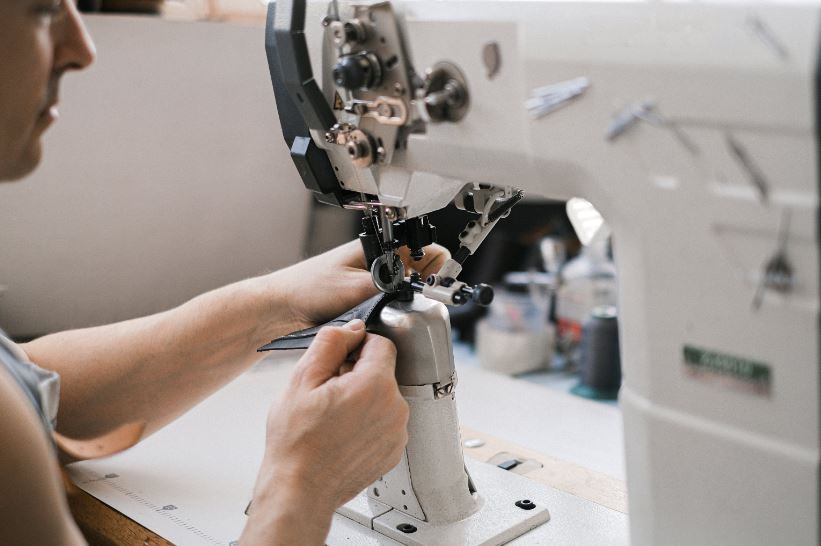
Servo Motors in Sewing: In the ever-evolving world of sewing technology, one of the most significant advancements is the integration of servo motors into sewing machines. These motors have revolutionized the way garments are crafted, providing greater precision, efficiency, and control to both hobbyists and professionals alike.
The Power of Servo Motors in Sewing Machines

Man Sewing Using Sewing Machine – Pexels
In this article, we’ll explore the wonders of sewing machine servo motors, understanding how they work and the impact they’ve had on the art of sewing.
Understanding Sewing Machine Servo Motors
A servo motor is a type of motor that uses feedback to control its speed and position. Unlike traditional sewing machine motors, which operate at a constant speed, servo motors can adjust their speed based on the user’s input and the requirements of the sewing process. This real-time responsiveness is a game-changer in the world of sewing.
Key Features and Benefits
- Precision Control: Servo motors allow for precise control over the sewing machine’s speed and movement. This level of accuracy is particularly beneficial for intricate stitching, embroidery, and other detailed work.
- Variable Speed: With a sewing machine servo motor, users can easily adjust the stitching speed according to the fabric type and sewing requirements. This flexibility ensures smoother and more professional-looking results across a variety of materials.
- Energy Efficiency: Traditional sewing machine motors operate at a constant speed, consuming a consistent amount of energy. Servo motors, on the other hand, only use power when needed. When the machine is idle, the motor is in standby mode, resulting in significant energy savings over time.
- Reduced Noise and Vibration: Servo motors are known for their quiet operation and minimal vibration. This not only creates a more pleasant working environment for sewers but also contributes to the longevity of the sewing machine itself.
- Compact and Lightweight Design: Sewing machine servo motors are typically smaller and lighter than their traditional counterparts. This makes modern sewing machines more portable and easier to handle, catering to the needs of sewers who attend workshops, classes, or sewing groups.
Impact on Sewing Industry
The integration of servo motors into sewing machines has had a profound impact on the sewing industry. Professionals and hobbyists alike have experienced increased productivity, efficiency, and creativity. Here are some ways in which servo motors have influenced the sewing landscape:
- Faster Production Times: The precise control and variable speed of servo motors enable faster and more efficient sewing. This is particularly valuable for businesses involved in mass production, where time-saving measures translate directly to increased output.
- Expanded Creative Possibilities: Sewers can experiment with a wider range of materials and techniques due to the precise control offered by servo motors. From delicate fabrics to heavy-duty materials, the versatility of these motors opens up new creative possibilities for designers and artisans.
- User-Friendly Experience: The ease of use and adjustability of servo motors make sewing machines more accessible to individuals of all skill levels. Beginners can enjoy a smoother learning curve, while experienced sewers appreciate the enhanced control and efficiency.
In Comparison to Clutch
In the world of machinery, two common types of systems, the clutch and servo, play crucial roles. Let’s break down the basics of each:
Clutch
A clutch is a mechanical device used in machines, especially vehicles, to connect and disconnect power transmission. It engages and disengages the engine from the transmission, allowing the driver to control the movement of the vehicle. Clutches are commonly found in manual transmission cars, where the driver manually shifts gears.
Key Points:
- Mechanism for connecting and disconnecting power transmission.
- Often used in manual transmission vehicles.
- Requires manual operation by the user.
- Commonly found in traditional machinery.
Servo
A servo, short for servomechanism, is an automatic device that uses feedback to control the motion or position of a system. It typically consists of a motor, sensors, and a controller. Servos are widely used in various applications, from robotics to industrial machinery, where precise control and automation are essential.
Key Points:
- Automatic control system with feedback.
- Utilizes a combination of motor, sensors, and controller.
- Enables precise and automated movement or position control.
- Commonly found in automated and computer-controlled systems.
In summary, while a clutch is a manual device for connecting and disconnecting power transmission, a servo is an automatic control system designed for precise and automated motion or position control. The choice between a clutch and a servo depends on the specific application and the level of control and automation required.
Conclusion
Sewing machine servo motors have undoubtedly transformed the sewing landscape, bringing about a new era of precision, efficiency, and creativity. As technology continues to advance, we can expect further innovations that will empower sewers and revolutionize the art of creating garments. Whether you’re a seasoned professional or a novice enthusiast, the integration of servo motors in sewing machines marks a significant step forward in the pursuit of perfection in every stitch.











